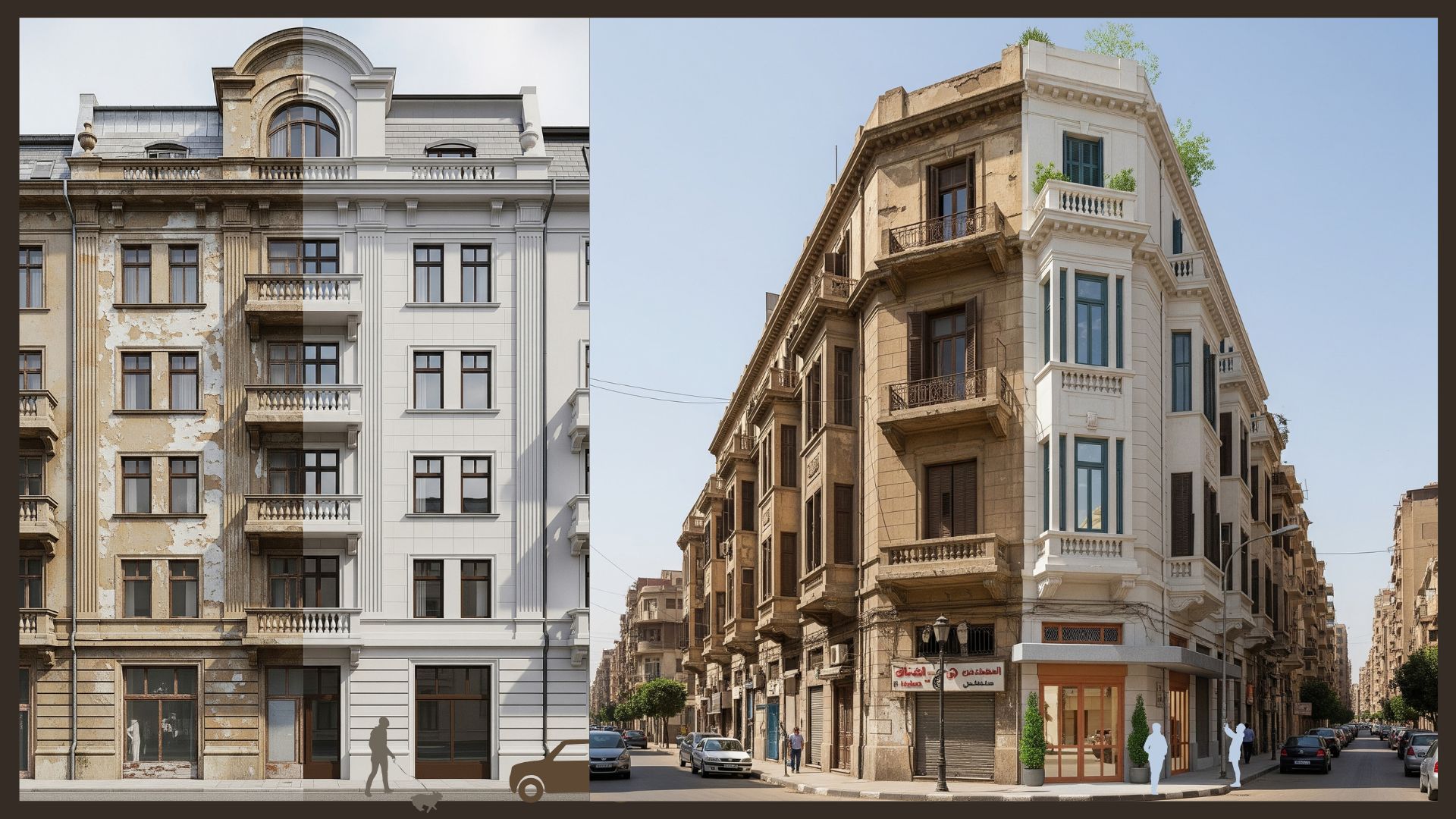Showcasing urban challenges through visual storytelling on social media is both a branding strategy and a design philosophy. It does more than highlight architectural problems; it positions the architect as a civic-minded, culturally grounded, and solution-oriented professional. Today, this could be a strategic brand advantage.
An example of this in practice is the work of the Egyptian architect Mostafa Salem. Mustafa has gained visibility through his popular Cairo Makeover Series on social media. He documents neglected buildings and public blocks in Cairo and proposes elegant, culturally appropriate renovations. His videos combine narration, context, and design proposals to connect with thousands, including potential clients, collaborators, and policy influencers.
Here’s an insight on how his strategy works, why it’s effective, and how you can adopt a similar approach.
The Problem; Urban Gaps and Civic Blind Spots
Most cities are filled with underutilized, decaying, or forgotten spaces. These neglected urban fragments are more than aesthetic failures; they represent lost social, cultural, and economic potential.
Yet these “gaps” often remain untouched due to budget constraints, bureaucratic hurdles, or simply public invisibility. This is where architects can step in, not just to propose new structures, but to reimagine existing ones and lead the conversation about urban transformation.
The Opportunity; Building Trust Through Visual Storytelling
In today’s digital age, sharing the architectural process and urban narratives on social media does more than showcase design expertise. It builds genuine trust and humanizes the architect’s role. By telling compelling stories about the challenges and transformations within cities, architects create meaningful emotional connections with their audience. This approach becomes a powerful touchpoint in the customer journey, resonating deeply with communities, clients, and collaborators alike.
Visual storytelling enables architects to:
- Demonstrate expertise by tackling real, visible urban issues.
- Forge authentic local connections that reflect cultural and social values.
- Amplify visibility through engaging, shareable digital content.
- Attract aligned clients such as developers, city planners, and fellow professionals who value thoughtful, solution-driven design.
This strategy transforms architects from distant professionals into trusted civic partners, opening doors to new opportunities and lasting impact.
The Strategy; Branding the Narrative
Instead of waiting for perfect commissions, start sharing your design thinking process; the real ideas and observations that make you a valuable thinker and professional.
This strategy involves:
- Filming local blocks or building façades that feel outdated, unsafe, or misused.
- Narrating your critique and vision — what’s not working, and what could work better.
- Sharing “before and after” ideas, sketches, or renderings that show transformation.
- Explaining the cultural, climatic, or functional rationale behind your design choices.
- Publishing consistently via short-form videos or long-form narratives on social media.
By documenting neglected areas and demonstrating your thought process, you turn content into proof of value; a living portfolio of your design mindset.
Why This Works
This approach doesn’t just show off your work. It establishes you as:
- A problem-solver who sees beyond surface issues.
- A community-engaged designer who respects place and culture.
- A visionary who brings clarity to complex urban problems.
- A firm that doesn’t just sell architecture; it leads conversations.
Your firm becomes not just a service provider, but a brand with a clear ethos: thoughtful, civic-minded, solution-driven.
You’re not just building a following; you’re building trust with ‘future‘ clients
How to Start Today; A Quick Framework
1. Pick a Local Space
Look around your neighborhood for opportunities where you can make a difference; spaces like a neglected bus stop, disused façade, or a poorly lit alley. Document it with photos or a short video.
2. Frame a Story
Why does this space matter? What’s broken? What could it become? Speak clearly and simply; your audience may not be other architects, but future clients or collaborators. Tell their story too.
3. Show Your Process
Include sketches, voiceovers, or diagrams. Even rough ideas are better than silence.
4. Post Consistently, Not Perfectly
Consistency matters more than polish. A short clip regularly builds a presence and positions you as proactive and insightful.
5. Archive on Your Website
Turn every post into a long-form blog, tagged with relevant. This improves searchability and positions your site as a trusted hub. Use trending keywords for SEO like “urban revitalization architect”, “culturally responsive design”, “public space reactivation”.
How This Converts into Clients
People, not just private homeowners, but developers, municipalities, and other architects, are drawn to clarity and action. By framing your design ability as civic service and urban critique, you:
- Earn visibility on search engines.
- Build credibility on social media.
- Attract mission-aligned clients who already trust your approach.
Ponder This; Authority Is Built, Not Claimed
Your voice is your strongest asset. Use it. Reimagine a forgotten corner of your city. Document your ideas with compassion, intelligence, and care. Post it. Then do it again next week.
Your brand will grow. Your audience will find you. And your firm will stand out; not just for what you design, but for what you see and how you envision it!

Leave a Reply